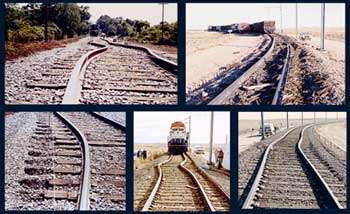Rail stressing

Stressing is a technique developed in the 1960s to avert rail track problems that can occur following installation of Continuous welded rail (CWR).
When installing new rail, or before the onset of hot weather, the rail is pulled or stretched by hydraulic tensors or heated along its entire length to an equivalent length to that which the rail would be at 27 °C (in the UK), which is known as the Stress Free temperature.
Technique
Unconstrained large sections of steel will shrink as the temperature drops, and expand as it increases. Since the ends of CWR are fixed, the rail will experience tensile stress in extreme cold and can fracture if it grows too great. In extreme heat it will experience compressive stress, and if that force grows too strong the tracks may buckle.
Many conditions affect the stability of track when under thermal forces. The temperature in the rail plays a great part but stability is also affected by ballast, sleepers (type and quantity), ballast shoulders, areas of shadow or tunnels and bridges, track consolidation and to a lesser degree vertical curvature of the tracks.
Imagine a one kilometre length of CWR that has some stress in it. The rail is restrained by being fixed to the sleepers/ties. Also imagine a one kilometre length of rail lying on the ground next to the track. In a hot summer, the unconstrained rail lying next to the track is going to expand, while the fixed rail will experience compression. The unconstrained rail will expand to become longer than one kilometre. Likewise, in extreme cold, the unfixed rail will shrink and become shorter than one kilometre, while the rail that is constrained to one kilometre in length will experience tension.
Obviously, there is a temperature at which a given length of the rail fixed to the track would be equal to a given length of the unfixed rail. This is known as the "rail neutral temperature". Note that rail neutral temperature does not actually measure the temperature of the rail. It is simply a reference to the temperature of the uninstalled rail before it is affixed to the sleepers. Immediately after any rail is installed into sleepers and is clipped down it becomes susceptible to changes in temperature and reacts by attempting to expand and/or contract along its length. Rail Neutral Temperature does not exist in installed rail.
When working with rail (laying new track, repairing track, or changing the sleepers/ties), this rail is mechanically or thermally altered to achieve a measured length equivalent to a stress free temperature of 27 °C before it is clipped down. This action ensures that at a known temperature of 27 °C it is expected that there would be no thermal forces, either compressive or contractive, in the rail.
The process of stressing rail installs the proper stress free temperature so that there will be a greatly reduced risk of fracturing or buckling at the temperature extremes. Since environmental extremes will vary, there is no universally applied stress free temperature. In the UK all Continuous Welded Rail is stressed to 27 °C (81 °F), the mean summer rail temperature. US standards range from 35 to 43 °C (90 to 110 °F), depending in large part on expected temperature range over the course of a year in a given region.
Conditions that affect the installed stress arise through lots of activities. It is accepted that any action that disturbs the ballast, track components, geometry and rails will affect the 'Critical Rail Temperature' and cause the stability of the track to be subject to adverse thermal forces. A typical example would be when a piece of rail has been removed due to a defect, or when an Insulated block joint (IBJ) is to be replaced. In cases such as these, the stressing engineer would ensure that the old rail is measured and marked with 'TellTale' indicators on the foot of the rail at the extremities of the replaced length. The rail would then be 'Flame Cut', and the clips securing it to the sleepers/ties are removed starting at the point of the cut outward to the limit of renewal. The existing defective rail is then cut out and movement at the 'tell tales' noted for re-instatement. The stressing engineer will then calculate the 'Original Stress free temperature' of the removed section and determine how much stress, if any has been lost and needs replacing. The new rail is fitted and welded at one end. The new rail is then cut to suit the Calculated length and a stressing kit is then fitted at the end still to be welded. The kit is clamped to the rail and it pulls the gap together, leaving enough space for a second weld. Once the rail is stressed to the appropriate temperature the weld is made. After setting the weld and an appropriate cooling period of time has elapsed, the stress kit is removed.
In an emergency, if the rail has buckled, it may be necessary to remove a section of the rail to restore the track. Later, a stress check on both rails must be carried out.
The stress free temperature of rails can change over time, and one rail cannot be assumed to have the same level of stress as the other, particularly where track components are aged and there is evidence of sleepers being 'out of square'. also where the line is subject to heavy traffic conditions. Besides re-instating the stress free temperature when making repairs, Verse testing is sometimes employed to give an indication of the levels of stress in the rails and to help the engineer prioritise where 'stressing' may be necessary under normal track maintenance.[1]
See also
- Buckling#Surface materials (sun kink)
External links
- ↑ NR Standards - Management of CWR